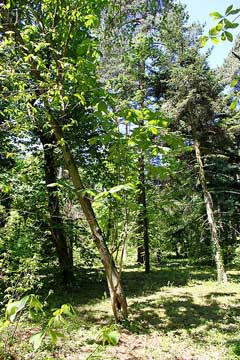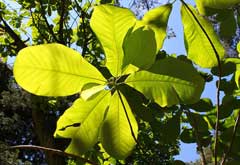 |
|
http://commons.wikimedia.org/wiki/User:Crusier |
 |
| http://commons.wikimedia.org/wiki/User:Crusier |
Translate this page:
Summary
Physical Characteristics

 Magnolia_officinalis is a deciduous Tree growing to 20 m (65ft) by 12 m (39ft).
Magnolia_officinalis is a deciduous Tree growing to 20 m (65ft) by 12 m (39ft).
See above for USDA hardiness. It is hardy to UK zone 8. It is in flower from May to June, and the seeds ripen from August to October. The species is hermaphrodite (has both male and female organs) and is pollinated by Beetles.
Suitable for: light (sandy), medium (loamy) and heavy (clay) soils and prefers well-drained soil. Suitable pH: mildly acid, neutral and basic (mildly alkaline) soils. It can grow in semi-shade (light woodland) or no shade. It prefers moist soil. It can tolerate atmospheric pollution.
UK Hardiness Map
US Hardiness Map
Synonyms
Plant Habitats
Edible Uses
References More on Edible Uses
Medicinal Uses
Plants For A Future can not take any responsibility for any adverse effects from the use of plants. Always seek advice from a professional before using a plant medicinally.
Hou Po has been used in Chinese herbal medicine for at least 2,000 years. The aromatic, pungent and warming bark is used in the treatment of various disorders of the digestive system[254]. Ophthalmic[46, 61, 109, 174]. The flowers are an aromatic digestive tonic[238]. A decoction of the flower buds is an esteemed emmenagogue in China, their use is therefore contraindicated for pregnant women[218]. The flowers are used in the treatment of abdominal distension, shortness of breath etc[176, 238]. They are harvested in the summer and can be used fresh or dried[238]. The stem bark is antiseptic, antispasmodic, aphrodisiac, appetizer, diuretic, expectorant, hypotensive, stomachic and tonic[46, 61, 109, 147, 174, 176, 218]. The bark is used internally in the treatment of abdominal distension, loss of appetite, gastro-enteritis, vomiting, diarrhoea, asthma and coughs with acute phlegm[147, 174, 176, 218, 238]. The bark is harvested in the autumn and dried for later use[238]. It does not store well so stocks should be renewed annually[238]. The plant is digestive and stomachic[218]. Extracts of the plant contain bactericidal compounds and an essential oil, they are effective against salmonella[218].
References More on Medicinal Uses
The Bookshop: Edible Plant Books
Our Latest books on Perennial Plants For Food Forests and Permaculture Gardens in paperback or digital formats.

Edible Tropical Plants
Food Forest Plants for Hotter Conditions: 250+ Plants For Tropical Food Forests & Permaculture Gardens.
More

Edible Temperate Plants
Plants for Your Food Forest: 500 Plants for Temperate Food Forests & Permaculture Gardens.
More

More Books
PFAF have eight books available in paperback and digital formats. Browse the shop for more information.
Shop Now
Other Uses
Wood - fine grained. It is said to be a useful wood.
Special Uses
References More on Other Uses
Cultivation details
Best grown in a warm position in a moderately rich free soil of an open texture[1]. The branches are brittle so a sheltered position is required[200]. Very tolerant of atmospheric pollution[200]. Hardy to about -10°c[200]. The fleshy roots are easily damaged and any transplanting is best done during a spell of mild moist weather in late spring[182].
References Carbon Farming Information and Carbon Sequestration Information
Temperature Converter
Type a value in the Celsius field to convert the value to Fahrenheit:
Fahrenheit:
The PFAF Bookshop
Plants For A Future have a number of books available in paperback and digital form. Book titles include Edible Plants, Edible Perennials, Edible Trees,Edible Shrubs, Woodland Gardening, and Temperate Food Forest Plants. Our new book is Food Forest Plants For Hotter Conditions (Tropical and Sub-Tropical).
Shop Now
Plant Propagation
Seed - best sown as soon as it is ripe in a cold frame. Stored seed must be kept cold over the winter and should be sown in late winter in a cold frame[200]. The seed usually germinates in the spring but it can take 18 months. Prick out the seedlings into individual pots when they are large enough to handle and grow them on in light shade in a cold frame or greenhouse for at least their first winter. They can be planted out into their permanent positions when they are more than 15cm tall, though should be well mulched and given some protection from winter cold for their first winter or two outdoors. Layering in early spring[200].
Other Names
If available other names are mentioned here
Native Plant Search
Search over 900 plants ideal for food forests and permaculture gardens. Filter to search native plants to your area. The plants selected are the plants in our book 'Plants For Your Food Forest: 500 Plants for Temperate Food Forests and Permaculture Gardens, as well as plants chosen for our forthcoming related books for Tropical/Hot Wet Climates and Mediterranean/Hot Dry Climates. Native Plant Search
Found In
Countries where the plant has been found are listed here if the information is available
Weed Potential
Right plant wrong place. We are currently updating this section.
Please note that a plant may be invasive in one area but may not in your area so it’s worth checking.
Conservation Status
IUCN Red List of Threatened Plants Status :

Growth: S = slow M = medium F = fast. Soil: L = light (sandy) M = medium H = heavy (clay). pH: A = acid N = neutral B = basic (alkaline). Shade: F = full shade S = semi-shade N = no shade. Moisture: D = dry M = Moist We = wet Wa = water.

Expert comment
Author
Rehder.&E.H.Wilson.
Botanical References
11200266
Links / References
For a list of references used on this page please go here
Readers comment
© 2010, Plants For A Future. Plants For A Future is a charitable company limited by guarantee, registered in England and Wales. Charity No. 1057719, Company No. 3204567.